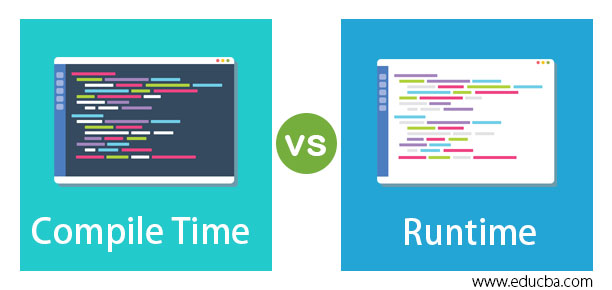
Introduction to Compile-time vs Runtime
In computer terms, compile time is referred to as the program’s time to compile the program by following some operations. These operations are followed by a part known as the compiler. These operations are done in order to convert the code written in a particular programming language so that it can be converted into corresponding machine language. For example, just assume that you would have to gather a lot of requirements, and the people from you have to gather are from different demographic zones, each capable of understanding only their native language. Hence all these languages must be converted into a language that you can understand so that the collection of elements to start the project is complete without any blockers.
An interesting fact about runtime is that, long ago, technical writers insisted on writing something like “when a program is run”, and due to this continuous repeating of phrase, it became obvious to use a new term, and that’s how “runtime” word came into existence and use. So now formally putting the words, that runtime is usually referred to when a program is running. In a program life cycle, the program’s total time starting to run in the memory until the user or the operating system terminates the program is essentially known as runtime.
Head to Head Comparison between Compile-time vs Runtime (Infographics)
Below are the top 6 comparisons between Compile-time vs Runtime:
Key differences between Compile-time vs Runtime
Let us discuss some key differences between Compile-time vs Runtime in the following points:
- So now, with much further ado, let us drive through the differences in runtime and compile time. The first level of difference is the instance at which the compile-time or runtime comes into play. Compile-time is when the code development is in progress, and the developer tries to compile the code written to convert that into a code that a machine can interpret. On the contrary, run time is essentially that time when the code has been developed and pushed to an environment to run it, and the time starts from the moment the first line of code starts getting executed.
- The next difference is in the hierarchy level on which these 2 belong. As per the various insights we have had, compile-time is the time that is measured when the code language has been converted to machine-understandable language, and from there, the code is executed. So if we have to place the chronology, it would be the compile time is calculated first, and then the runtime.
- Now we would look at the polymorphism technique in compile time vs runtime. In the case of compile-time, the method to be executed is decided during the compilation of the code, and the datatype which invokes the object is looked at. On the contrary, in the case of polymorphism in runtime, the object needed for executing the method is not known beforehand, and hence the code is compiled. When the flow of the code starts, it is only then the methods know what object is coming towards it for execution.
- The next difference is in terms of error reporting. In compile-time, the errors are reported, and it is about syntax or semantics that the code is looked into, whereas, in a runtime error, the error is referenced from the time when the code starts its execution. A compiler is the element that detects the compile-time error, whereas it is in a runtime environment where the runtime error is detected, where runtime security also plays a key role. One can easily fix the compile-time error during development without running it in a production-simulated environment, whereas runtime error can’t be 100% foolproof without running it in a runtime environment.
Comparison Table of Compile-time vs Runtime
The table below summarizes the comparisons between Compile-time vs Runtime:
| Genre | Compile-time |
Runtime |
| When does the time start? | This is when the code is translated from a programming language to a language that a machine understands. | This is when a code is run in the runtime environment and starts from the time code execution starts till the point the user or OS stops the code. |
| Where does it come in the hierarchy? | This occurs well in advance in software development. | After the software development is complete, it comes into play when the code is executed in a runtime environment. |
| Polymorphism | The code understands and checks for the object, which invokes a method. | The code cannot understand which object is invoking the method, and code is compiled without knowing that information. |
| Compile-time error – Reference | These errors are referenced to an error in syntax or semantics. | These errors are a reference to the execution of the code in a runtime environment. |
| Compile-time error – Detect | This error can be detected during software development. | This error might come up even when the code is run in a runtime environment, even if it has passed in the local. |
| Compile-time error – Fix | These errors can be fixed during the code development itself. | These errors are rather difficult to interpret during development and can be fixed only when it starts showing up in the runtime environment. |
Conclusion
In conclusion, we have had an in-depth understanding of the difference between a compile-time and a runtime and also appreciate the niche differences these have, and once we are in the process of software development, it will be far easier for us to understand.
Recommended Articles
This is a guide to Compile-time vs Runtime. Here we discuss the Compile-time vs Runtime top key differences with infographics and comparison table. You may also have a look at the following articles to learn more –

